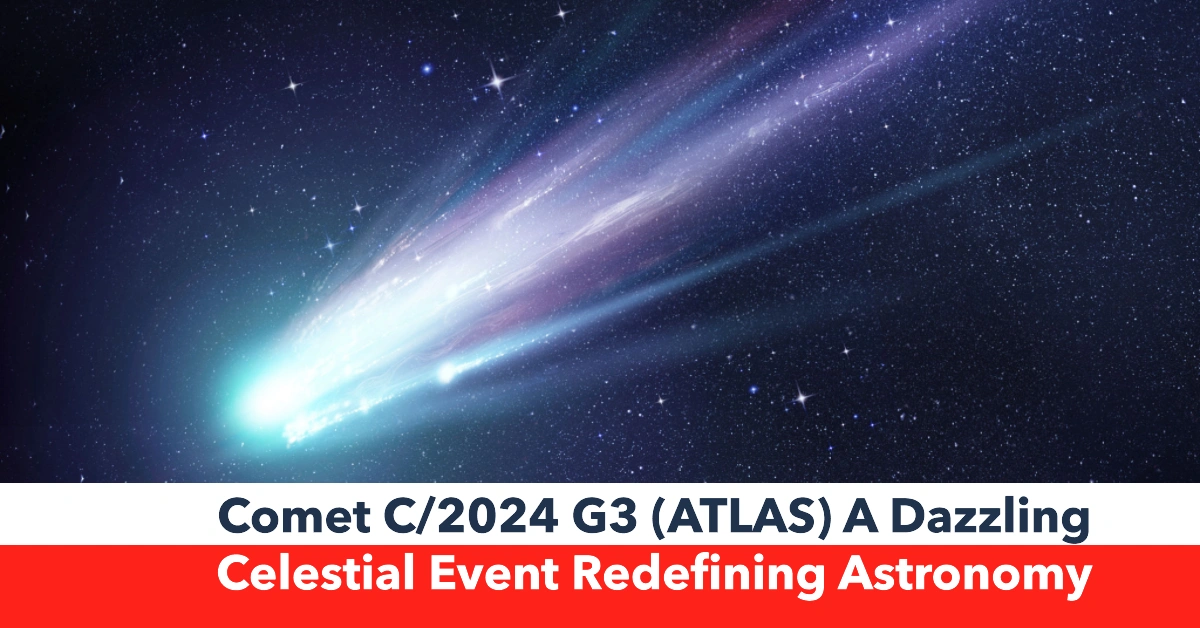Get ready, stargazers—a rare and spectacular cosmic event is about to unfold! Comet C/2024 G3 (ATLAS) is set to illuminate the night skies, offering Southern Hemisphere observers a breathtaking celestial display unlike any seen in years.
This isn’t just another comet—it’s an astronomical phenomenon that bridges scientific discovery, technological advancements, and human curiosity, making it one of the most anticipated space events of 2024.
Table of Contents
Why Comet C/2024 G3 (ATLAS) Is a Must-See Event
Unlike many comets that require telescopes to be seen, C/2024 G3 (ATLAS) will be visible to the naked eye, making it a once-in-a-generation opportunity for amateur astronomers and casual skywatchers alike.
🌠 Key Features of Comet C/2024 G3 (ATLAS):
✔ Bright Nucleus & Extensive Tail → Offers a clear and mesmerizing view, even without specialized equipment.
✔ AI-Enhanced Telescopes → Allow for unprecedented insights into its structure and origins.
✔ Scientific Breakthroughs → Could reshape our understanding of the solar system.
For space enthusiasts, this is more than just a comet—it’s a scientific treasure trove traveling through our cosmic backyard.
Tesla Confirms Cybertruck’s Stainless Steel Exoskeleton Won’t Be Used in Future Vehicles
The Role of Advanced Technology in Observing the Comet
Thanks to AI-driven telescopes and space-based observatories, astronomers now have the tools to study comets like never before.
🔭 How Technology Is Revolutionizing Astronomy:
✔ AI-Enhanced Imaging → Produces crystal-clear observations, helping scientists analyze the comet’s composition and trajectory.
✔ Space-Based Observatories → Provide a detailed look at the comet’s structure, helping scientists learn more about the early solar system.
✔ Data-Driven Research → Helps predict future comet behavior and refine our knowledge of cosmic evolution.
Beyond astronomy, these technological advancements have ripple effects in AI, telecommunications, and data analysis, proving that exploring the cosmos fuels innovation across industries.
What This Event Means for the Future of Astronomy
The arrival of Comet C/2024 G3 (ATLAS) represents a turning point in how we study celestial objects. The growing integration of AI and optical advancements in telescopes opens new doors to deeper space exploration.
📈 Expected Outcomes:
✔ Further investment in space exploration and cutting-edge telescope technology.
✔ Expansion of AI in astronomy, enhancing real-time celestial monitoring.
✔ Greater public interest in space sciences, fostering new educational opportunities.
Astronomers predict that this event will drive further advancements in observational tools, leading to even more spectacular discoveries in the years to come.
How to View Comet C/2024 G3 (ATLAS): Best Times and Locations
If you’re in the Southern Hemisphere, you’re in luck! The best viewing period is late 2024, with optimal visibility in areas with minimal light pollution.
📍 Best Locations to Watch:
✔ Australia & New Zealand → Dark-sky reserves offer prime viewing conditions.
✔ South America → Elevated regions provide excellent clarity.
✔ South Africa → Limited urban light makes for an ideal stargazing experience.
☁ Weather Warning: Clear skies are essential for the best viewing experience. Check local forecasts to avoid cloud cover obstructing your view.
Pros and Cons of Observing Comet C/2024 G3 (ATLAS)
While this celestial marvel brings excitement, there are also challenges to consider.
✅ Pros:
✔ Naked-eye visibility makes it accessible to everyone.
✔ Advancements in AI and telescopic technology push the boundaries of space exploration.
✔ Generates public interest in astronomy, sparking educational opportunities.
❌ Cons:
🚫 Limited to the Southern Hemisphere, restricting global access.
🚫 Weather-dependent—cloud cover could obstruct views.
🚫 Brief visibility window, requiring precise timing to observe.
Despite these challenges, Comet C/2024 G3 (ATLAS) remains one of the most exciting astronomical events of the decade.
Revolutionary Invention Turns Plastic Waste into Home Energy – No Solar Panels Needed!
DeepSeek: The Chinese AI Startup Disrupting the Global AI Industry
Beyond AI Hype: Three Strategic Steps to Transform Accounting Firms with Practical AI Integration
Final Thoughts: A Cosmic Connection Between Humanity and the Universe
Beyond its scientific significance, Comet C/2024 G3 (ATLAS) serves as a reminder of our deep connection to the cosmos.
🔭 This event is more than just a celestial show—it’s a reflection of human curiosity, technological progress, and our continuous quest to understand the universe.
So, whether you’re an experienced astronomer or just someone who loves to look up and wonder, don’t miss the chance to witness this incredible cosmic phenomenon.
📢 Mark your calendars, grab your binoculars, and prepare to be amazed! 🌠✨

One thought on “Comet C/2024 G3 (ATLAS): A Dazzling Celestial Event Redefining Astronomy, Technology, and Our Connection to the Cosmos”